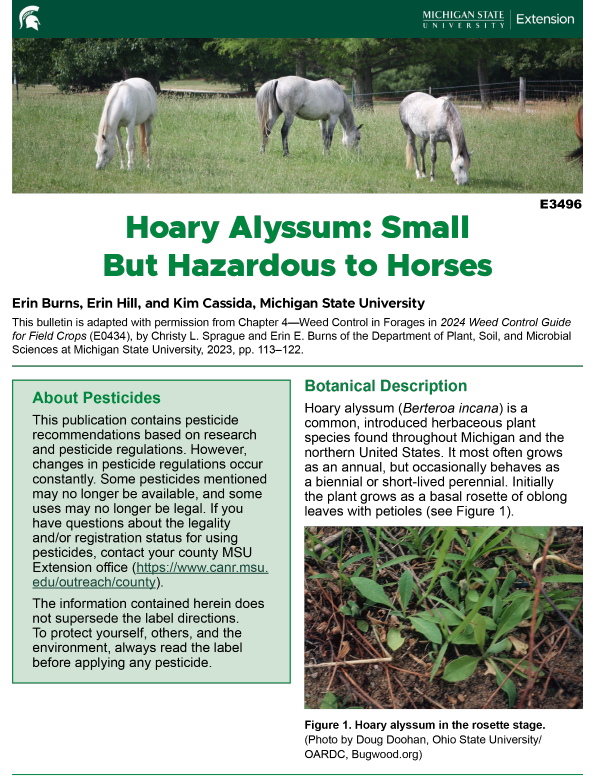
Bulletin E3496
Hoary Alyssum: Small But Hazardous to Horses
DOWNLOAD
June 25, 2025 - Erin Burns, Erin Hill and Kim Cassida, Michigan State University
This bulletin is adapted with permission from Chapter 4—Weed Control in Forages in 2024 Weed Control Guide for Field Crops (E0434), by Christy L. Sprague and Erin E. Burns of the Department of Plant, Soil, and Microbial Sciences at Michigan State University, 2023, pp. 113–122.
About Pesticides
This publication contains pesticide recommendations based on research and pesticide regulations. However, changes in pesticide regulations occur constantly. Some pesticides mentioned may no longer be available, and some uses may no longer be legal. If you have questions about the legality and/or registration status for using pesticides, contact your county MSU Extension office.
The information contained herein does not supersede the label directions. To protect yourself, others, and the environment, always read the label before applying any pesticide.

Botanical Description
Hoary alyssum (Berteroa incana) is a common, introduced herbaceous plant species found throughout Michigan and the northern United States. It most often grows as an annual, but occasionally behaves as a biennial or short-lived perennial. Initially the plant grows as a basal rosette of oblong leaves with petioles (see Figure 1).
As the plant grows, it forms upright branches, the leaves become more elongated (see Figure 2), and the petioles become shorter and eventually disappear (Neal et al., 2023). All leaves, stems, and flower buds are covered with tiny star-shaped hairs, giving the plant a gray-green appearance. White flowers develop in clusters at the top of branches. The four flower petals are white and each has a distinctive deep notch, making it look like the flower has eight petals (see Figure 3).
Over time, the flower spike elongates and produces more flowers. Seeds form in flattened, oval-shaped pods that have two chambers and a distinct beak at the top (see Figure 4). Each plant can produce over 2,500 seeds per year (Warwick & Francis, 2006) that may be viable for up to nine years (Parkinson et al., 2017). Even after the seeds have been shed, the pod stays on the plant stem and the thin wall between the pod’s chambers and its beak are still visible. Look for the distinctive pod and beak when inspecting hay.
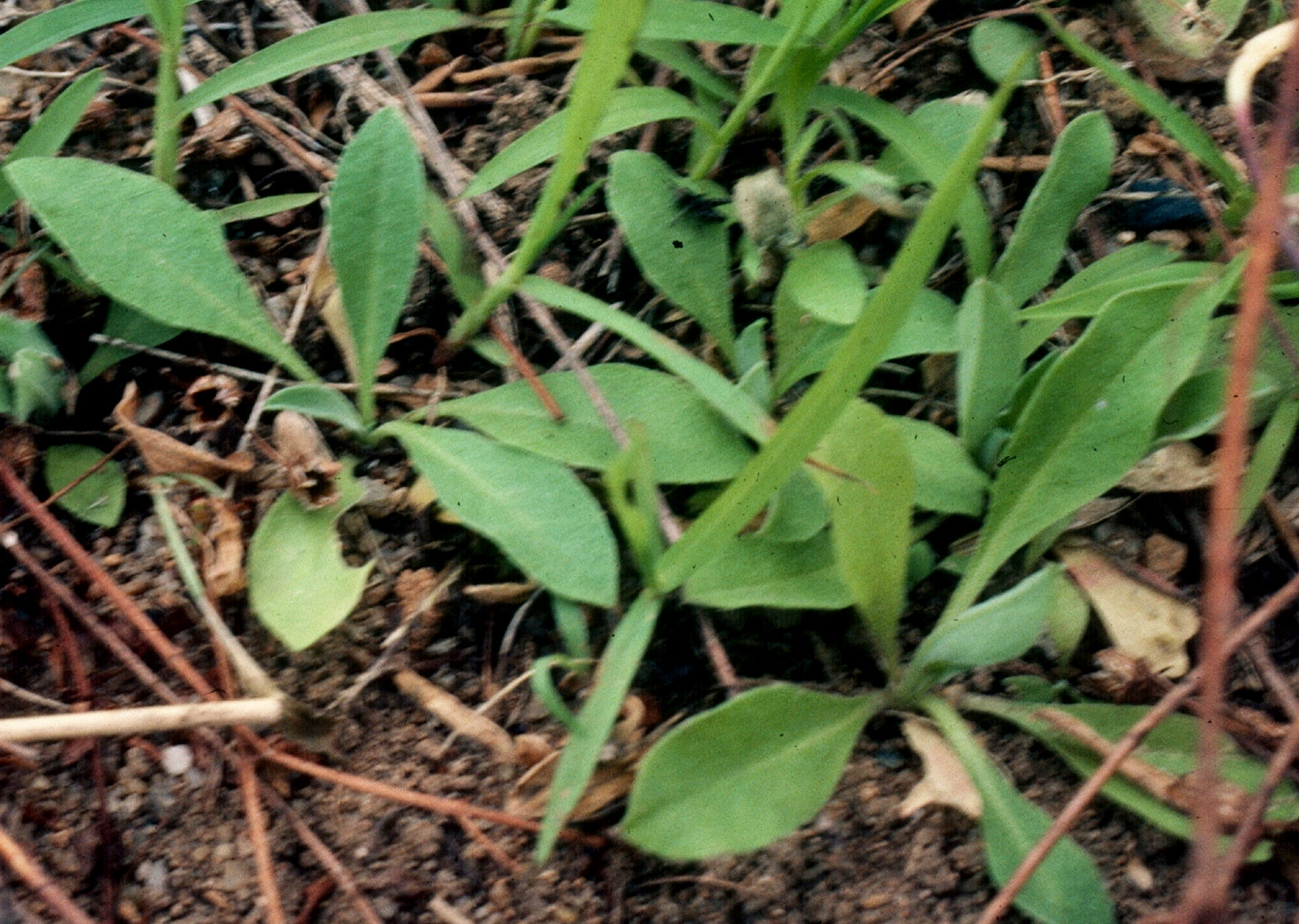
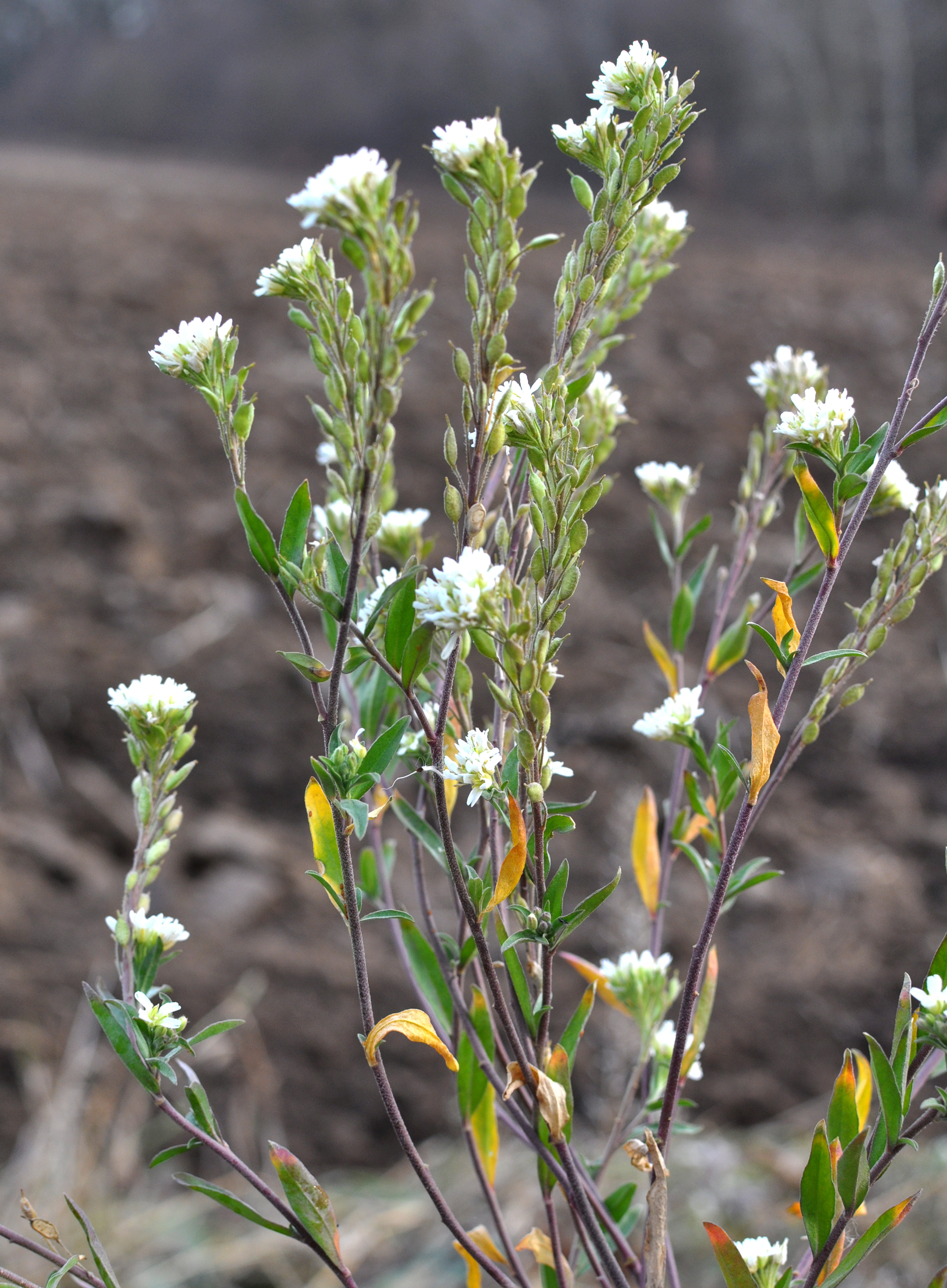
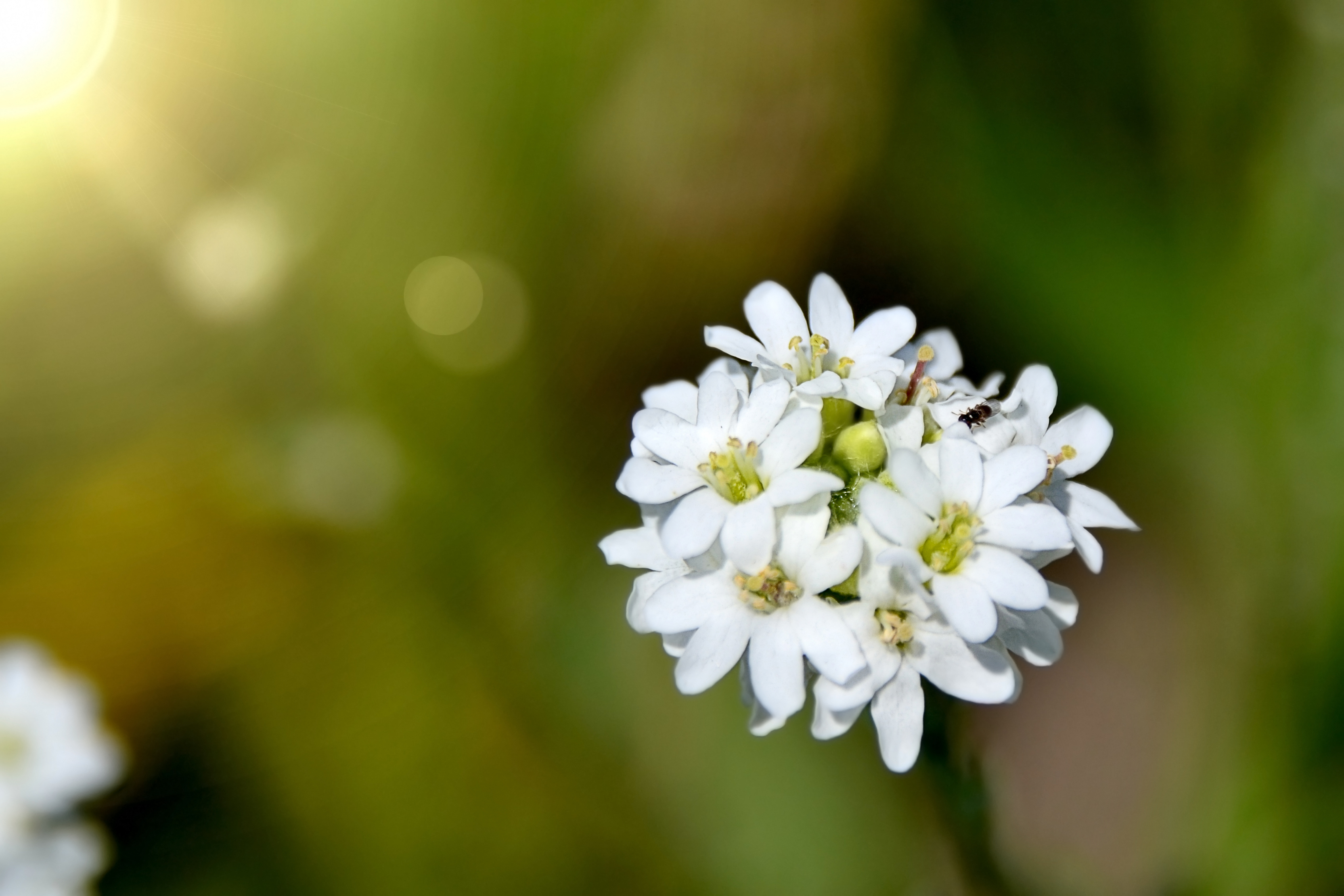
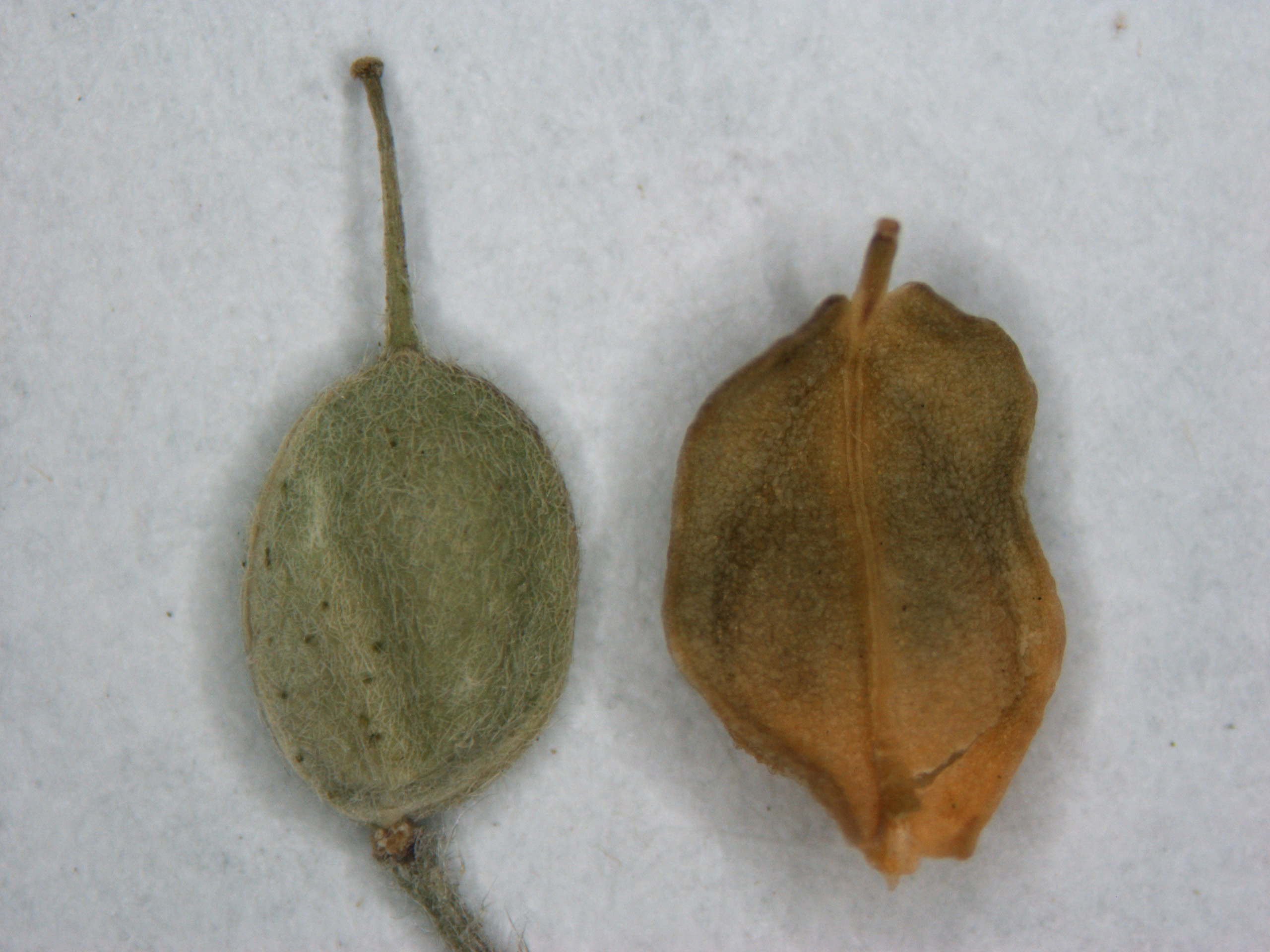
While hoary alyssum is found throughout Michigan, it tolerates dry conditions and is most common on disturbed sites, in sandy soil, and in areas of low fertility. Hoary alyssum can often be found in hay and alfalfa fields, fencerows, roadsides, thin lawns (see Figure 5), and in perennial crops like orchards and Christmas trees (Neal et. al, 2023; Warwick & Francis, 2006).
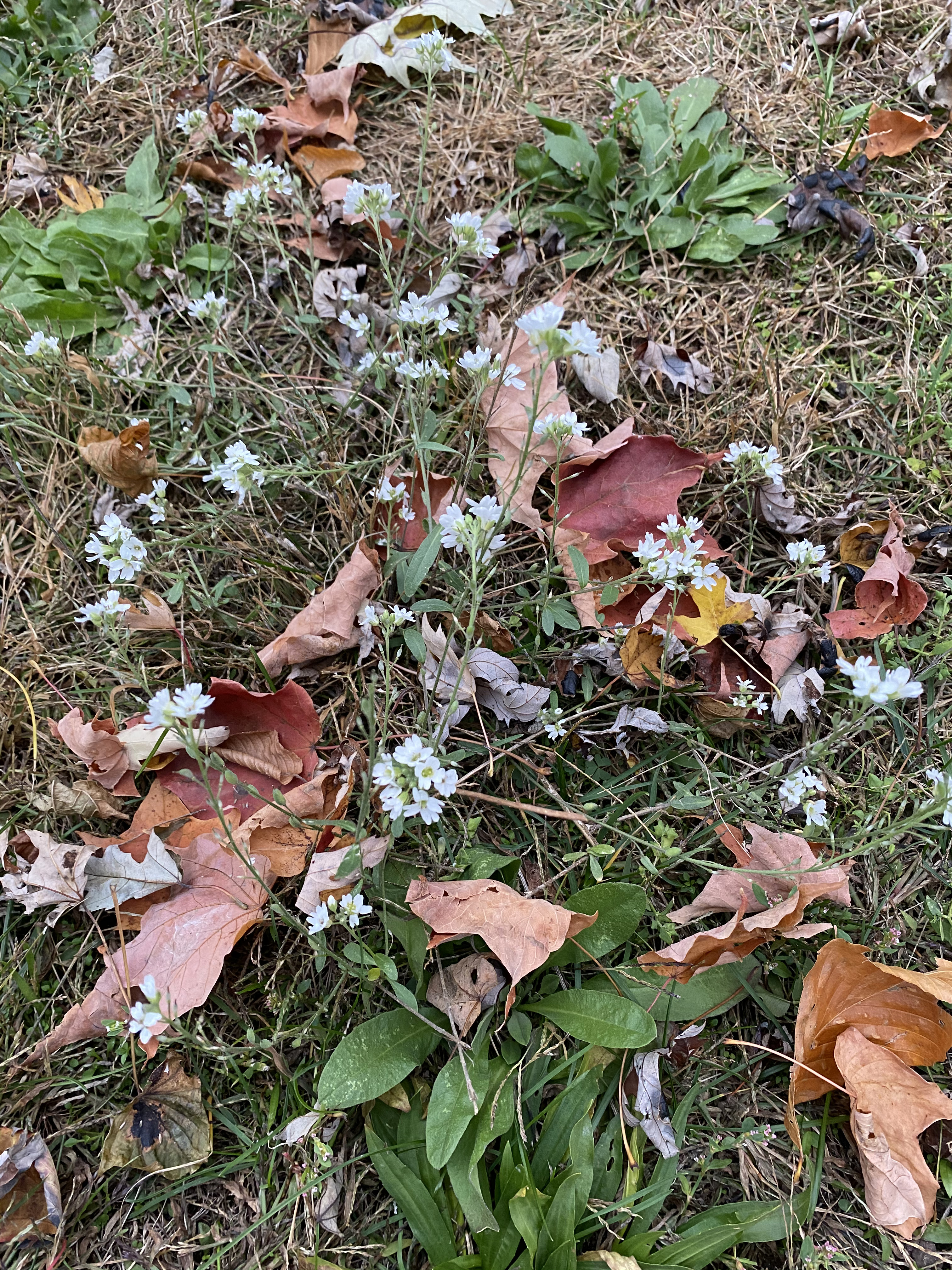
The upright stalks are the part of the plant most often seen in hay. To distinguish hoary alyssum stalks from grass sheaths, look for alternate leaves going up the stem. If the leaves have fallen off, you still should be able to see the leaf bases or the scars where the leaves were attached. Grass sheaths, by contrast, are smooth and sometimes have nodes but they have no leaves or scars at the point of the node.
Hoary alyssum stems are round and nearly the same diameter for their whole length. The stem diameter and gray-green color can help you tell them apart from alfalfa stems, which are greener and do not feel round but more like they have distinct edges (see Figure 6). The gray tinge on hoary alyssum comes from the star-shaped hairs growing along the stems, which you can see using a hand lens or other magnifier (see Figure 7). If seedpods or the remnants of seedpods are present, look for the beak, too (see Figure 4). If flower buds are present, look for star-shaped hairs on the gray-green outer tissues. Pull the bud open and use a hand lens to look for notches in the underdeveloped petals (see Figure 8).

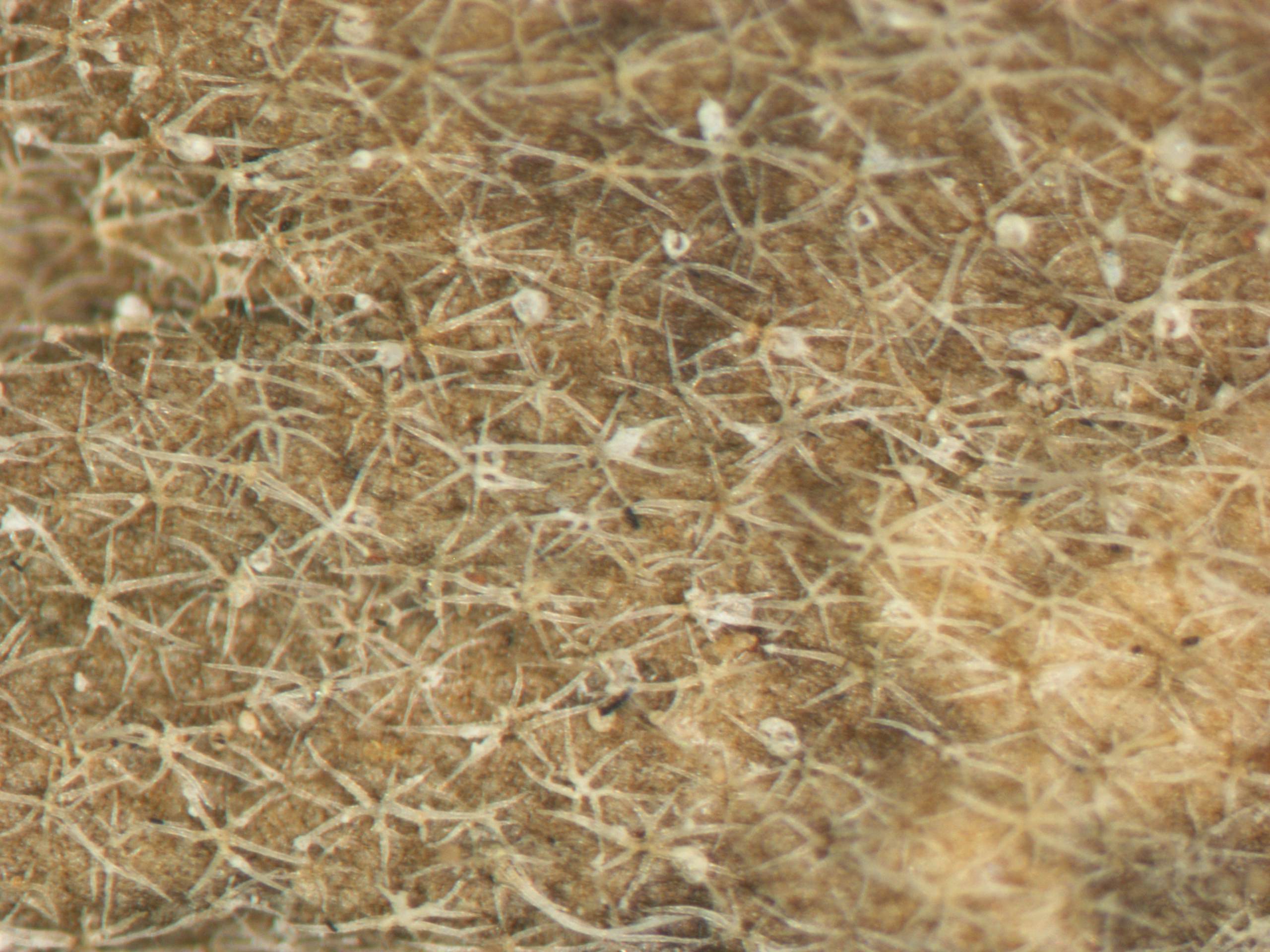
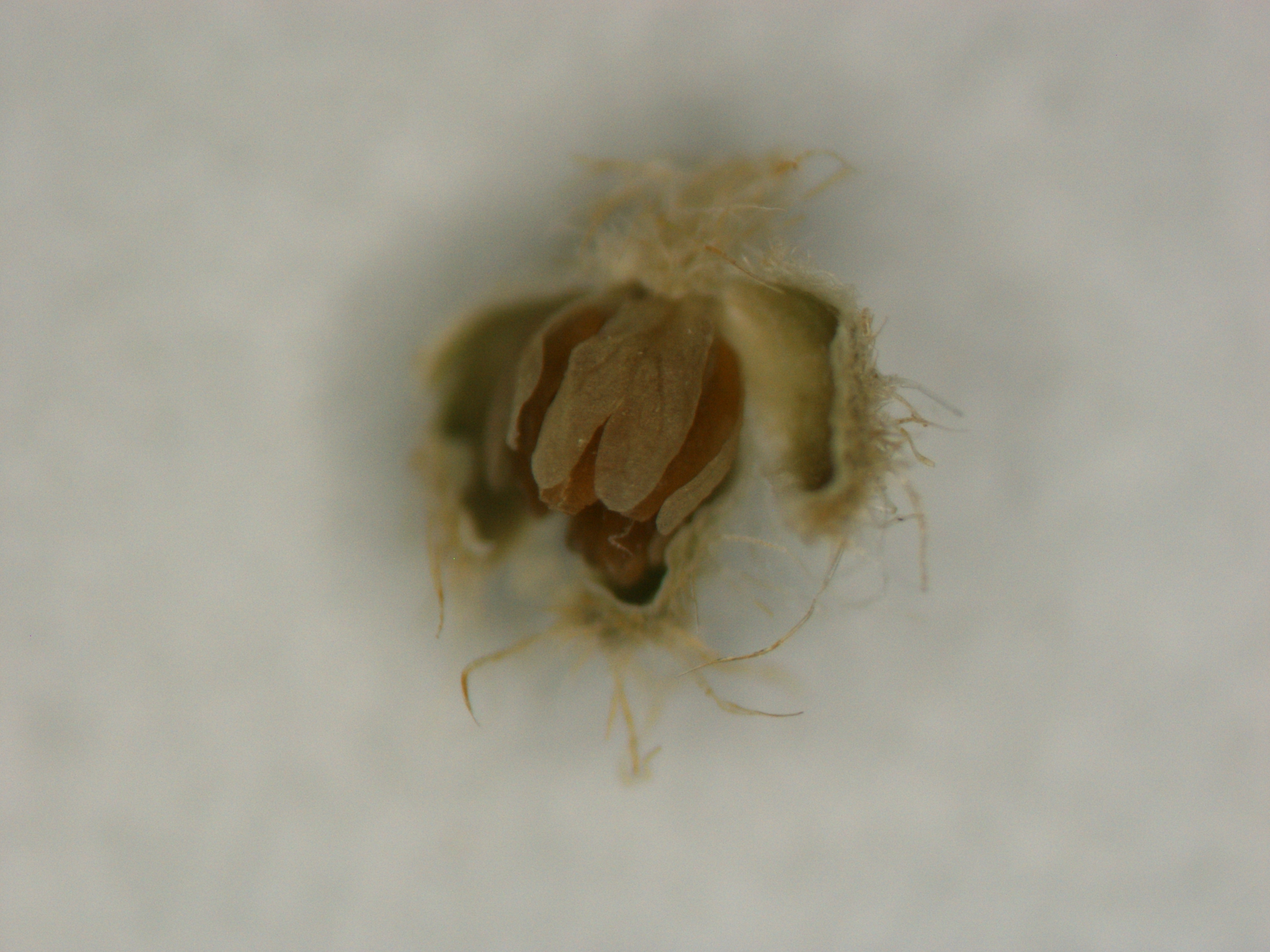
Toxicity Issues
Hoary alyssum is toxic to horses and ponies whether they eat it fresh while grazing or in dried hay. It doesn’t taste good, so horses are unlikely to eat it in pastures if better forage is available. But when it’s mixed in hay, hoary alyssum is harder to avoid. While we found no documented cases of hoary alyssum poisoning in mules or donkeys, it is prudent to avoid feeding hoary alyssum to these equines also.
The toxin in hoary alyssum hasn’t been identified, and no commercial test is available to detect the plant or its toxin in hay. Opening and searching hay bales for the dried plant is the only way to tell if the hay is safe. The plant may only grow in a few spots in a hayfield, and toxic amounts may only be present in a few bales or in a few flakes in a single bale in a load of hay.
Scientists from the Natural Resources Conservation Service report that hoary alyssum can be harmful if it makes up 30% or more of hay or forage by weight (Noack et al., 2020). Some animals, however, may react to even lower levels. Others may not be affected by the toxin at all. Because reactions vary, MSU experts recommend never feeding any hay with hoary alyssum in it to horses.
Hoary alyssum is known to be toxic in hay for at least nine months after baling (Noack et al., 2020). Whether the toxin is still active after that hasn’t been studied, but there is little reason to think the toxin would ever disappear in well-stored hay.
The signs of hoary alyssum poisoning in equines include depression, fluid retention in the lower legs, fever, stiff joints, diarrhea, laminitis, and founder (Geor et al., 1992). Signs appear 18 to 24 hours after an animal has eaten a toxic dose. There is no treatment other than removing the plant from the diet and providing supportive care.
Most horses recover in three to four days. Eating hoary alyssum is rarely directly fatal, but it may lead to severe laminitis and founder, which can be hard to treat successfully and may result in the affected animal having to be euthanized.
Hoary alyssum is not known to be toxic to any other animal species, including ruminants (cattle, sheep, and goats), dogs, cats, and humans. Cattle, sheep, and goats can safely eat hay and pasture containing hoary alyssum.
Management in Forages
The best way to control hoary alyssum in forages is to establish and maintain vigorous forage stands that can out-compete the weeds. Vigorous stands greatly reduce the need to apply herbicides. If the health of a forage stand declines, weeds will become established in it. Then, unless the management problem that caused the forage decline is corrected, the desired forage won’t grow or reestablish itself, and weeds will continue to infest the stand. Hoary alyssum often becomes a problem after forage stands are stressed by factors such as poor fertility, overgrazing, drought, and winterkill from harsh winters.
To maintain a highly competitive forage crop, follow these management recommendations:
- Plant suitable forage species for the site and local climate. Guidelines for matching forage species to sites can be found in Recommended Hay and Pasture Forages for Michigan (E3309; http://bit.ly/4j4tgSw).
- Maintain soil fertility to fight weeds. Test soil or plant tissue (or both) at least every three years and correct any pH or fertility issues that show up in the results. Hay crops remove large amounts of soil nutrients that must be replaced to keep the soil’s fertility from dropping over time. Forage species differ in their nutrient requirements and nutrient-stressed forage crops can’t compete with weeds.
- Plan harvest schedules so perennial forages have a chance to fully recharge the nutrient stores in their roots and crowns after each harvest. Weakened forages may die, then weeds will invade.
- Avoid overgrazing pastures. Overgrazing weakens desirable species by not allowing them to recharge the nutrient stores in their roots and crowns. Again, weakened forages may die and weeds will invade.
The MSU Forage Connection (forage.msu.edu) has detailed information on managing forage crops.
Control
Control of hoary alyssum is critical before the first seeding of a hayfield or pasture. Weeds like hoary alyssum should be controlled in the previous crop or in the fall before a spring seeding because options for control are limited after a forage crop has been seeded.
Start off weed-free by tilling the field or applying a nonselective, burndown herbicide (such as glyphosate or paraquat) to a no-till field before planting. Controlling weeds before planting will improve the forage quality and help prevent stand loss due to weed competition.
Scouting
Some Michigan hay producers have been sued after they have unknowingly sold hay containing hoary alyssum to consumers who fed it to their horses. You can help protect yourself, your horses, and your hay buyers by regularly scouting for hoary alyssum in hayfields intended for horse feed. If you find the weed, sell the hay from that field as feed for animals other than horses.
Scouting can help you detect a new infestation while it is small and you can control it using spot methods such as digging or pulling out a few plants and roots. Don’t let a new infestation of hoary alyssum you have discovered shed seeds, or the problem will spread.
Use good field sanitation so you don’t move weed seeds from a weedy hayfield to a clean one on field or hay harvest equipment. Clean weed seeds and chaff off equipment between fields using water or compressed air, and always harvest weedy fields last. Insist on these practices if you are hiring a custom hay harvest service.
Using Herbicides
Table 1. How and when to use seven herbicides labeled for use in forage legumes and their effectiveness ratings in controlling hoary alyssum.
| Herbicide |
Active ingredient or common name |
Crop type |
Application timing |
Application rate per acre |
Effectiveness rating |
|---|---|---|---|---|---|
| 2,4-DB (Butyrac 200 2L & others | 2,4-DB | Seedling legumes | Postemergence | 2 qt |
Fair |
| Buctril/Moxy 2L & others |
bromoxynil |
Seedling legumes | Postemergence | 1 pt |
Fair |
| Eptam 7EC | EPTC | Seedling legumes | Preplant incorporated | 3.5 pt |
Fair |
| Metribuzin | metribuzin | Established alfalfa | Dormant *, ** | 0.67 lb | Excellent |
|
Sinbar |
terbacil | Established alfalfa | Dormant | 1.25 lb | Good |
| Velpar | hexazinone | Established alfalfa | Dormant | 0.67 lb | Excellent |
| Glyphosate | glyphosate | Glyphosate-resistant alfalfa | Postemergence | 0.75 lb ae + AMS 17 lb/100 gal**** |
Good |
Note. Read and follow precautions on the product label and in “Remarks and Limitations” in the source guide. Table adapted from Chapter 4—Weed Control in Forages in Weed Control Guide for Field Crops (E0434), by C. L. Sprague and E. E. Burns, 2025 (updated annually).
* Dormant = apply to dormant alfalfa in late fall or early spring. ** Can be used on mixed alfalfa-grass stands. *** NIS = Non-ionic surfactant; v/v = volume NIS per volume of total spray solution; *** AMS = ammonium sulfate. **** ae = acid equivalent.
Table 2. Four postemergence herbicides labeled for use in established forage grasses and their application rates and effectiveness in controlling hoary alyssum.
| Postemergence herbicide | Active ingredient or common name | Application rate per acre | Effectiveness rating |
|---|---|---|---|
| 2,4-D ester 4L | 2,4-D ester | 1 qt | Good |
| Banvel/Clarity 4L | dicamba | 1 qt | Good |
| Banvel/Clarity 4L + 2,4-D ester 4L | Dicamba + 2,4-D ester | 0.5 pt + 1.5 pt | Good |
| Cimarron Plus 63WG | Metsulfuron + chlorsulfuron | 0.25 oz + NIS 0.125% v/v * | Excellent |
Note. Read and follow precautions on the product label and in “Remarks and Limitations” in the source guide. Table adapted from Chapter 4—Weed Control in Forages in Weed Control Guide for Field Crops, (E0434), by C. L. Sprague and E. E. Burns, 2025 (updated annually).
* NIS = Non-ionic surfactant; v/v = volume NIS per volume of total spray solution.
Pastures and hay fields grown for horse consumption are commonly grass-alfalfa mixtures. Unfortunately, there is only one broadleaf herbicide active ingredient, metribuzin, labeled for control of hoary alyssum on grass-alfalfa mixes because other active ingredients pose significant risks of injury to alfalfa. Metribuzin is a dormant-season herbicide with an extremely narrow application window based on the weather immediately before application.
High metribuzin application rates may damage desirable grasses. In general, dormant season applications to alfalfa mixes are made using low rates in the late fall, winter, or early spring when:
- Alfalfa is not growing and is less than 2 inches tall.
- Hoary alyssum is no more than 2 inches tall.
- Stands are not snow-covered.
- Desired plants are not stressed.
- Fields are dry enough to drive on.
Management Beyond Hay & Forages
In other crops, hoary alyssum may not be a hazard, but control may still be needed to improve aesthetics or to keep it from competing with desirable plant species. This section offers information on controlling hoary alyssum in turfgrass and Christmas trees. If you need to manage hoary alyssum in another crop or setting, contact your local MSU Extension office or MSU Plant and Pest Diagnostics.
In Turfgrass
Hoary alyssum is not typically a problem in dense, robust turfgrass, but it can exploit weak stands. Working toward a lush and healthy lawn is the best way to prevent an infestation. Do this by:
- Increasing mowing heights to 3 inches or taller
- Fertilizing the turfgrass once or twice a growing season
- Irrigating the turfgrass in dry weather.
Mowing helps reduce the seed production potential of hoary alyssum, but the plants can still branch and produce flowers and seed below mowing heights. Hand pulling or digging out plants are options for small infestations.
Preemergence
Not many herbicides are labeled specifically for hoary alyssum control in cool-season turf. Applying preemergence products before the weed seeds germinate is one way to prevent future infestations, but the application timing would depend on location, because hoary alyssum seeds can germinate throughout the growing season. Active ingredients with preemergence activity include dithiopyr, pendimethalin, and prodiamine. Preemergence applications can’t be done at the same time that you reseed thin areas of grass. Check the herbicide label to see how long you must wait after the application to reseed.
Renovation
As mentioned earlier, when hoary alyssum plants are already present, products that contain the active ingredient 2,4-D would be expected to have good activity, though reapplication may be necessary.
If a pasture or field is severely infested with hoary alyssum, renovation may be recommended. In that case you could use a herbicide with glyphosate as the active ingredient to kill the hoary alyssum and the turf. If you are considering a renovation using a herbicide with a different active ingredient, consult your local MSU Extension office or MSU Plant and Pest Diagnostics. After the treated plants have died, you can replant the area.
In Christmas Trees
Hoary alyssum can also be a problem in Christmas tree production. For information on controlling hoary alyssum in Christmas trees, see Weed Control in Christmas Trees (E3237; canr.msu.edu/resources/weed-control-in-christmas-trees-e3237).
References
Cassida, K. & Kaatz, P. (2019). Recommended hay and pasture forages for Michigan (E3309). http://bit.ly/4j4tgSw
Geor, R. J., Becker, R. L., Kanara, E. W., Hovda, L. R., Sweeney, W. H., Winter, T. F., Rorick, J. K., Ruth, G. R., Hope, E., & Murphy, M. J. (1992). Toxicosis in horses after ingestion of hoary alyssum. Journal of the American Veterinary Medical Association, 201(1), 63–67. https://doi.org/10.2460/javma.1992.201.01.63
Neal, J. C., Uva, R. H., DiTomaso, J. M. & DiTommaso, A. (2023). Weeds of the Northeast (2nd ed.). Comstock Publishing Associates, an imprint of Cornell University Press.
Noack, R., Pokorny, M., Jacobs, J., & Mangold, J. (2020). Plant guide: Hoary alyssum: Berteroa incana (L.) DC. USDA, Natural Resources Conservation Service, Bridger Plant Materials Center. https://plants.usda.gov/DocumentLibrary/plantguide/pdf/pg_bein2.pdf
Parkinson, H., Mangold, J. & Jacobs, J. (2017). Biology, ecology, and management of hoary alyssum (EB0194). Montana State University Extension. https://store.msuextension.org/publications/AgandNaturalResources/EB0194.pdf
Sprague, C. L. & Burns, E. E. (2024; updated annually). Weed control guide for field crops (E0434; Online ed.). Michigan State University, MSU Extension. https://www.canr.msu.edu/weeds/
Warwick, S. I. & Francis, A. (2006). The biology of invasive alien plants in Canada. 6. Berteroa incana (L.) DC. Canadian Journal of Plant Science, 86(4). 1297–1309. https://doi.org/10.4141/P06-030
This work is supported by the Crop Protection and Pest Management Program [grant no 2024-70006-43569] from the USDA National Institute of Food and Agriculture. Any opinions, findings, conclusions, or recommendations expressed in this publication are those of the author(s) and do not necessarily reflect the view of the U.S. Department of Agriculture.



 Print
Print Email
Email


